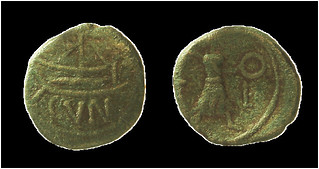
PREV ARTICLE
NEXT ARTICLE
FULL ISSUE
PREV FULL ISSUE
MORE ON PLASTER CASTS IN COIN PHOTOGRAPHYI flat ran out of time to get everything into last week's issue. Here's a set of earlier responses from readers regarding plaster casts in coin photography. Thanks, everyone, and sorry for the delay. -Editor Harry Cabluck writes: Regarding the question about photographing plaster casts of coins in the analog days, a time of slow film and before the halftone process of photographic reproduction. It may be that foil impressions of obverses and reverses were made of each coin. It would work especially well with high relief ancient coins. The foil mold(s) could have been filled with plaster of Paris. The excess plaster trimmed away. Photographing plaster, the white of which could be toned down with tea, would eliminate reflections as seen in metal and would help reduce the density range in the photograph of the coin. Eliminating the spectral highlights solves many problems. Second, By photographing casts, all of the obverses and all reverses could have been imaged in one exposure. So a page layout of half a dozen coins could have been shot on one piece of film... 12 images. George Frederick Kolbe writes: Plaster coin casts became popular in the 1870s, up until the mid-20th century and a bit beyond. The “why” has been addressed. Typically, the plaster casts were then utilized in photographic printing processes such as autotype, collotype, heliotype, woodburytype, and so on. Though never inexpensive, these technologies were more practical and substantially less expensive than photographic prints. A popular, ubiquitous, still useful “modern” work on coins, namely, R.A.G. Carson’s 1962 “Coins of the World,” features 64 collotype plates. It was reprinted several times, into the 1970s. Bob Van Arsdell writes: Making plaster casts of coins predates the invention of photography. Initially, plaster casts of rare medals and ancient coins were made and sold as “student sets”. They were a means by which students and scholars could have access to the imagery without having access to the coins. The practice was common in the 18th century (if I recall correctly) and probably began much earlier. When coin photography began, casts were often used instead of the coins for publication work. The plaster completely eliminates the specular (mirror-like) reflections from a coin’s surface. These reflections can obscure the images on the coins. Photographing casts removes the shininess and gives a better representation of the imagery. Casts also eliminate any discoloration on a coin surface. The use of plaster casts has nothing to do with the sensitivity of the film - coins can be photographed using long exposure times. Plaster casts were used for high-quality numismatic publications in Britain from the 1870s onward. Their use declined after the First World War. A late example appears in Proceedings of the Prehistoric Society, volume 44, 1978. A Ship Type coin of Cunobeline (early-mid first century AD Britain) needing a casting to see the image better. The copper coin was somewhat corroded and the discoloration obscured the imagery in a direct photograph. The article provides a good example of how a coin’s surface can affect the photographic results. The accompanying plate shows both the direct coin photo and that of the cast.  The PPS article also provides a good example of something else - that important numismatic information often appears in archaeological publications. To read the earlier E-Sylum articles, see:  Wayne Homren, Editor The Numismatic Bibliomania Society is a non-profit organization promoting numismatic literature. See our web site at coinbooks.org. To submit items for publication in The E-Sylum, write to the Editor at this address: whomren@gmail.com To subscribe go to: https://my.binhost.com/lists/listinfo/esylum All Rights Reserved. NBS Home Page Contact the NBS webmaster 
|